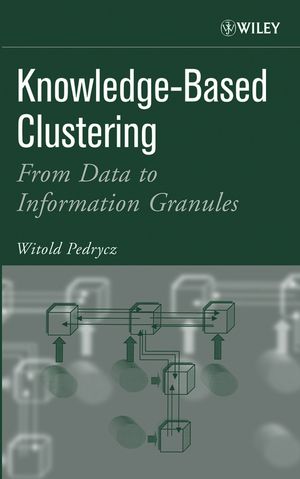Knowledge-Based Clustering: From Data to Information GranulesISBN: 978-0-471-46966-7
Hardcover
336 pages
January 2005
 This is a Print-on-Demand title. It will be printed specifically to fill your order. Please allow an additional 10-15 days delivery time. The book is not returnable.
|
||||||
Preface.
1. Clustering and Fuzzy Clustering.
1. Introduction.
2. Basic Notions and Notation.
2.1 Types of Data.
2.2 Distance and Similarity.
3. Main Categories of Clustering Algorithms.
3.1 Hierarchical Clustering.
3.2 Objective Function – Based Clustering.
4. Clustering and Classification.
5. Fuzzy Clustering.
6. Cluster Validity.
7. Extensions of Objective Function-Based Fuzzy Clustering.
7.1 Augmented Geometry of Fuzzy Clusters: Fuzzy C-Varieties.
7.2 Possibilistic Clustering.
7.3 Noise Clustering.
8. Self Organizing Maps and Fuzzy Objective Function Based Clustering.
9. Conclusions.
References.
2. Computing with Granular Information: Fuzzy Sets and Fuzzy Relations.
1. A Paradigm of Granular Computing: Information Granules and their Processing.
2. Fuzzy Sets as Human-Centric Information Granules.
3. Operations on Fuzzy Sets.
4. Fuzzy Relations.
5. Comparison of Two Fuzzy Sets.
6. Generalizations of Fuzzy Sets.
7. Shadowed Sets.
8. Rough Sets.
9. Granular Computing and Distributed Processing.
10. Conclusions.
References.
3. Logic-Oriented Neurocomputing.
1. Introduction.
2. Main Categories of Fuzzy Neurons.
2.1 Aggregative Neurons.
2.2 Referential (reference) Neurons.
3. Architectures of Logic Networks.
4. Interpretation Aspects of the Networks.
5. The Granular Interfaces of Logic Processing.
6. Conclusions.
References.
4. Conditional Fuzzy Clustering.
1. Introduction.
2. Problem Statement: Context Fuzzy Sets and Objective Function.
3. The Optimization Problem.
4. Computational Considerations of Conditional Clustering.
5. Generalizations of the Algorithm Through the Aggregation Operator.
6. Fuzzy Clustering with Spatial Constraints.
7. Conclusions.
References.
5. Clustering with Partial Supervision.
1. Introduction.
2. Problem Formulation.
3. The Design of the Clusters.
4. Experimental Examples.
5. Cluster-Based Tracking Problem.
6. Conclusions.
References.
6. Principles of Knowledge-Based Guidance in Fuzzy Clustering.
1. Introduction.
2. Examples of Knowledge-Oriented Hints and their General Taxonomy.
3. The Optimization Environment of Knowledge-Enhanced Clustering.
4. Quantification of Knowledge-Based Guidance Hints and Their Optimization.
5. The Organization of the Interaction Process.
6. Proximity – Based Clustering (P-FCM).
7. Web Exploration and P-FCM.
8. Linguistic Augmentation of Knowledge-Based Hints.
9. Concluding Comments.
References.
7. Collaborative Clustering.
1. Introduction and Rationale.
2. Horizontal and Vertical Clustering.
3. Horizontal Collaborative Clustering.
3.1 Optimization Details.
3.2 The Flow of Computing of Collaborative Clustering.
3.3 Quantification of the Collaborative Phenomenon of the Clustering.
4. Experimental Studies.
5. Further Enhancements of Horizontal Clustering.
6. The Algorithm of Vertical Clustering.
7. A Grid Model of Horizontal and Vertical Clustering.
8. Consensus Clustering.
9. Conclusions.
References.
8. Directional Clustering.
1. Introduction.
2. Problem Formulation.
2.1 The Objective Function.
2.2 The Logic Transformation Between Information Granules.
3. The Algorithm.
4. The Overall Development Framework of Directional Clustering.
5. Numerical Studies.
6. Conclusions.
References.
9. Fuzzy Relational Clustering.
1. Introduction and Problem Statement.
2. FCM for Relational Data.
3. Decomposition of Fuzzy Relational Patterns.
3.1 Gradient-Based Solution to the Decomposition Problem.
3.2 Neural Network Model of the Decomposition Problem.
4. Comparative Analysis.
5. Conclusions.
References.
10. Fuzzy Clustering of Heterogeneous Patterns.
1. Introduction.
2. Heterogeneous Data.
3. Parametric Models of Granular Data.
4. Parametric Mode of Heterogeneous Fuzzy Clustering.
5. Nonparametric Heterogeneous Clustering.
5.1 A Frame of Reference.
5.2 Representation of Granular Data Through the Possibility-Necessity Transformation.
5.3 Dereferencing.
6. Conclusions.
References.
11. Hyperbox Models of Granular Data: The Tchebyschev FCM.
1. Introduction.
2. Problem Formulation.
3. The Clustering Algorithm-Detailed Considerations.
4. The Development of Granular Prototypes.
5. The Geometry of Information Granules.
6. Granular Data Description: A General Model.
7. Conclusions.
References.
12. Genetic Tolerance Fuzzy Neural Networks.
1. Introduction.
2. Operations of Thresholdings and Tolerance: Fuzzy Logic-Based Generalizations.
3. The Topology of the Logic Network.
4. Genetic Optimization.
5. Illustrative Numeric Studies.
6. Conclusions.
References.
13. Granular Prototyping.
1. Introduction.
2. Problem Formulation.
2.1 Expressing Similarity Between Two Fuzzy Sets.
2.2 Performance Index (objective function).
3. Prototype Optimization.
4. The Development of Granular Prototypes.
4.1 Optimization of the Similarity Levels.
4.2 An Inverse Similarity Problem.
5. Conclusions.
References.
14. Granular Mappings.
1. Introduction and Problem Statement.
2. Possibility and Necessity measure as the Computational Vehicle of Granular Representation.
3. Building the Granular Mapping.
4. The Design of Multivariable Granular Mappings Through Fuzzy Clustering.
5. Quantification of Granular Mappings.
6. Experimental Studies.
7. Conclusions.
References.
15. Linguistic Modeling.
1. Introduction.
2. The Cluster-Based Representation of the Input – Output Mapping.
3. Conditional Clustering in the development of a blueprint of granular models.
4. Granular neuron as a Generic Processing Element in Granular Networks.
5. The Architecture of Linguistic Models Based on Conditional Fuzzy Clustering.
6. Refinements of Linguistic Models.
7. Conclusions.
References.
Bibliography.
Index.



